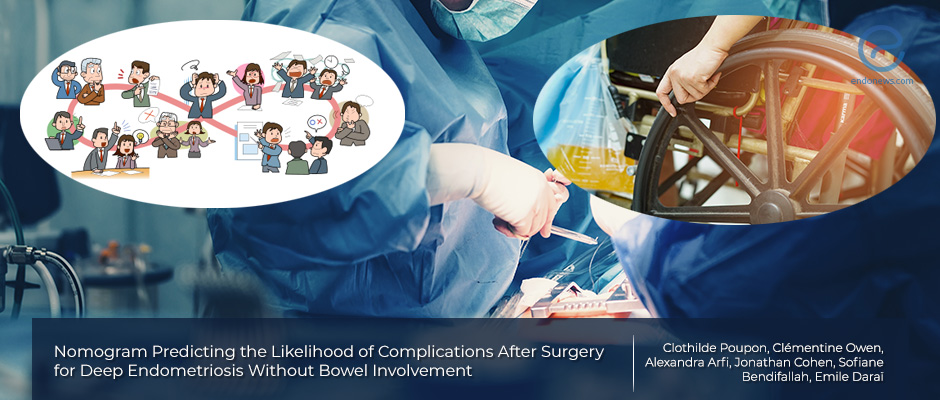How to predict complications for endometriosis surgery?
Aug 29, 2019
A nomogram is useful to assess the risk of postoperative complications for deep endometriosis.
Key Points
Highlights:
- Surgery for deep endometriosis without bowel resection was found to be highly associated with voiding dysfunction and minor postoperative complications.
- A nomogram may be helpful to both clinicians and patients about the risk of deep endometriosis surgery.
Importance:
- Better patient information about the risk of deep endometriosis surgery will be possible.
Objective:
- The authors aimed to evaluate the incidence of complications after surgery for deep endometriosis without bowel involvement and to develop a nomogram for predicting their occurrence.
What's done here:
- The data of 222 patients with deep endometriosis without bowel involvement in the registry from January 2006 to December 2014 at Tenon University Hospital in Paris, France were analyzed.
- For each patient, they noted parameters including age at surgery, body mass index, smoking status, presence of endometrioma and adenomyosis on magnetic resonance imaging (MRI), fertility before surgery, symptoms, previous surgery for endometriosis, type of surgery, surgical route, Enzian and American Society for Reproductive Medicine (ASRM) scores calculated during surgery.
- The researchers evaluated surgery complications in the participants using the Clavien-Dindo classification (grade I-II: minor complications, grade III-IV: major complications, grade V: death).
Key Results:
- In the current study, the median age of the patients was 32 years [19–53]; the majority were nulliparous (73%); the BMI was 22.5 kg/m2 [14.1–35.8].
- Of all participants, 24% had postoperative complications during the first postoperative month, most of which had minor complications; most of which mainly related to urinary tract infection and treated by antibiotics.
- There were no grade IV-V complications.
- It was found that age, Enzian classification risk group, and previous surgery for endometriosis were significantly associated with postoperative complications.
- Consequently, the researchers developed a nomogram based on criteria including the age of the patient, previous surgery for deep endometriosis, and the Enzian classification. They stated that this nomogram may be used to predict the probability of complications after surgery for deep endometriosis without bowel involvement.
Limitations:
- This study was of retrospective nature, and the study period was long.
- Although it cannot be clearly categorized according to Clavien-Dindo classification, voiding dysfunction requiring self-catheterization for more than 1 month was included as a severe complication.
- The Enzian score calculation was based on intraoperative evaluation of deep endometriosis but not on MRI.
- Classifying the Enzian score into three risk groups is not subject to consensus.
Lay Summary
In a new study co-led by scientists at Sorbonne University, a nomogram is built to better inform patients about the risk of deep endometriosis surgery without bowel involvement.
The findings have been published in the European Journal of Obstetrics & Gynecology and Reproductive Biology: X, a peer-reviewed and open access mirror journal of the European Journal of Obstetrics & Gynecology and Reproductive Biology.
To find the incidence of complications after surgery for deep endometriosis without bowel involvement, Poupon C and colleagues retrospectively analyzed information on 222 patients with deep endometriosis without bowel involvement in the registry from January 2006 to December 2014 at Tenon University Hospital in Paris, France.
Parameters including age at surgery, body mass index (BMI), smoking status, presence of endometrioma and adenomyosis on magnetic resonance imaging, fertility before surgery, symptoms, previous surgery for endometriosis, type of surgery, surgical route, Enzian and American Society for Reproductive Medicine scores calculated during surgery were recorded for each patient.
Surgery complications in the participants were evaluated using the Clavien-Dindo classification (grade I-II: minor complications, grade III-IV: major complications, grade V: death). After collecting data, the investigators designed a nomogram to calculate patient-specific probabilities of complications after surgery for deep endometriosis without bowel involvement.
The researchers found that 24 percent of the participants had postoperative complications during the first postoperative month, most of which had Clavien-Dindo grade I-II complications. Among these, 90% were mainly related to urinary tract infection and treated by antibiotics. No grade IV-V complications were observed. Surgery for deep endometriosis without bowel resection was found to be highly associated with voiding dysfunction and only minor postoperative complications.
Age, Enzian classification risk group, and previous surgery for endometriosis were significantly associated with postoperative complications.
Following these findings, the researchers came up with a nomogram based on criteria including the age of the patient, previous surgery for deep endometriosis, and the Enzian classification for predicting the probability of complications after surgery for deep endometriosis without bowel involvement.
Finally, this French study suggests that the nomogram may be useful to evaluate the risk of severe postoperative complications associated with the resection of deep endometriosis without bowel involvement.
Research Source: https://pubmed.ncbi.nlm.nih.gov/31403118/
nomogram ASRM classification deep endometriosis Enzian classification endometriosis classification bowel endometriosis deep endometriosis postoperative complication endometriosis surgery endometriosis stage endo belly laparoscopy endometriosis stage 4 endometriosis stage 3 endometriosis what does endometriosis feel like endometriosis fatigue

